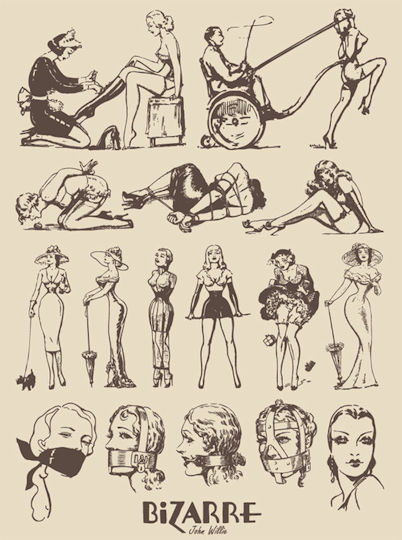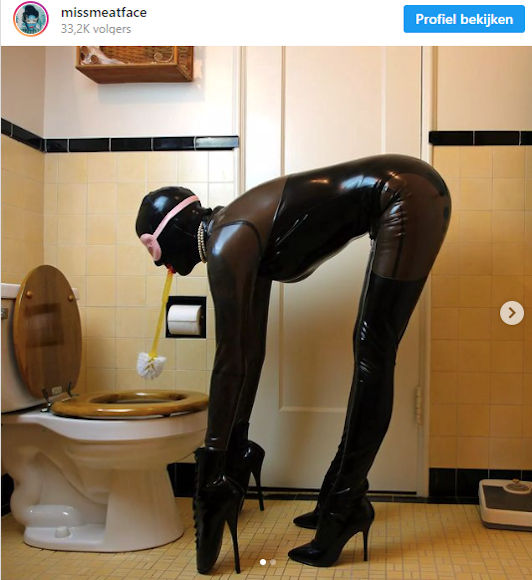Source: Messynessychic.com.
USA – A little slap and tickle – kinky or otherwise – has been good medicine for us down the ages. Public consumption of the practice of BDSM (Bondage and Discipline, Dominance and Submission, Sadochism and Masochism) really came into its own during a ‘golden age’ of fetish art in the mid 20th century. Fetish art has satisfied an enduring need to capture and privately preserve a subject too risqué or taboo for polite conversation. Voyeurism, through lavishly illustrated ‘instruction manuals’, was also a key ingredient of the practice; not only were they creative but also a book of rules: how far, how much and for how long. But richly illustrated records on the subject, albeit in limited quantity, have been around since the time of the ancients, surviving from some of the world’s oldest scriptures, frescoes and even tombs.

The tools of BDSM (whips, chains, masks, gags etc) have little changed over the millennia, with the good ol’ whip remaining a key icon. There is psychological arousal both for the dispenser of the ‘punishment’ and also for the receiver. Equally the light action of whipping and spanking activates blood circulation and gets the body more sensitive and releases endorphins, stimulating those parts and creating a pleasure rush in anticipation of sex. The oldest known image of this nature is hidden away in a dark 5th century BCE Etruscan tomb at the Necropoli dei Monterozzi in Italy.
Two naked men are pictured rather politely whipping a naked woman’s backside, while she in return pleasures both. A few centuries later and a little more public, in the Villa of the Mysteries in Pompeii, a painted plaster wall fresco wraps around a room’s walls showing a descending winged whip-handed female figure apparently dispensing a flagellation ritual to new bride. In this case, it’s thought the whip is not only a symbol of the future male-dominated marriage, but may also be the iconography of a rite of passage, from a carefree maiden to the spinning mistress of the household with the spindle-thread a metaphorical whip-lash.
From the same period, around the 3rd century CE, the Hindu Kama sutra from India celebrates erotic love. Whilst we are now so familiar with the 2,000-year-old guide by Indian philosopher Vatsyayana, within its pages you can also find a section describing “four different kinds of hitting during lovemaking, the allowed regions of the human body to target and different kinds of joyful cries of pain practiced by bottoms”. The ancient Indian Sanskrit text is thus considered “one of the first written resources dealing with sadomasochistic activities and safety rules”.
European art of the 18th and 19th centuries produced many one-off hot and erotic works captured in pencil and oil. With developments in printing, erotic material could be more easy copied and distributed. Do we even need to open the can of worms that is Marquis de Sade’s dungeon fantasies? Lesser-known and mostly visual and voyeuristic, perhaps the best exploration of the bondage theme was Leopold von Sacher-Masoch’s Venus in Furs, published in 1870. In this book not just the physical relationship of sexual power is explored, but also the political and psychological. It claims that until there is true equality, women will remain man’s ‘enemy’. The concepts of ‘enemy’ and ‘entanglement’ both physically and emotionally drive BDSM culture.
Fast forward to more modern times, with the industrialisation of printing and photography, fetish imagery could be easily and cheaply supplied to all who were interested. In America, Charles Guyette (1902 –1976) is regarded as the godfather of fetish art, producing and distributing film, fashion and print.
He would also be the first to go to jail for charges of indecency in 1935. Later crowned the “G-String King,” his key contribution was fetish photography featuring thigh-high boots, sharp heels and gartered fishnet stockings with supporting props of whips and hand-cuffs. Guyette was largely unknown in his own lifetime and operated under umbrellas of aliases, but those American and Canadian exponents who succeeded him – Irving Klaw, John Willie and Eric Stanton – would become part of an infamous circle of patrons, publishers, and subculture personalities described by fetish art historian Richard Pérez Seves has designated as the “Bizarre Underground.”
John Willie, British born John Alexander Scott Coutts (1902 –1962), was an artist, fetish photographer, editor and the publisher of the first 20 issues of the now legendary fetish magazine Bizarre, which ran from 1946 to 1959. He had a taste for photographing women in towering stilettos, but also had a hand in creating the fashion they wore. By 1945, he’d created his own line of ‘exotic’ footwear called, “Achilles,” perfected the G-String tie that even Houdini hated getting out of, and created a series of fetish fantasy characters like “Sweet Gwendolyn” and her dominatrix, “the Countess”.
John Willie’s art is accomplished and his published layouts graphically strong, the content lying somewhere between fashion and fetishism; with ladies impossibly balanced on their stilettos, they sport super-tight hourglass waisted corsets, displaying their bulging breasts and gartered legs. The gags and gear are what could now be considered high fashion items: corsets from the best lingerie stores, immaculate bodysuits, endless silk stockings and lacy garters.
Whist Bizarre Magazine was rich with John Willie’s own artworks, it also included photographs, often of his own wife. The magazine folded due to paper shortages of WWII. When he retired, he destroyed most of his archives, except for a few surviving shots.

Inspired by John Willie, the self-named the “Pin-up King”, Irving Klaw was a “merchant of sexploitation” who operated a mail-order fetish art business in New York for movies and kinky photographs. Klaw’s work in BDSM media was mainly post-war, a series of striptease and burlesque movies featuring the likes of 50s pin-up girl Bettie Page. Hugh Hefner himself alludes to the domino effect Irving had on her career and ultimately pop culture: “She became, in time, an American icon, her winning smile and effervescent personality apparent in every pose. A kinky connection was added by Irving Klaw’s spanking, fetish and bondage photos, which became part of the Bettie Page mystique; they were playful parodies that are now perceived as the early inspiration for Madonna’s excursions into the realm of sexual perversion.”
In the late 1950s, amidst a new wave of media censorship, a career-ending McCarthy-style hearing branded Klaw as a degenerate pornographer. Bettie Page retired from modeling soon after and Klaw destroyed an estimated 80% of his negatives (while his sister Paula secretly saved some of his work).
Perhaps one of the most influential cartoonists to feature in Klaw’s material was Eric Stanton, another American underground cartoonist and fetish art pioneer who helped shape the movement before its acceptance in the 1970s. Artists like Banksy, Allen Jones and Madonna, among others, took inspiration from his the work, but interestingly, for a decade, Stanton also shared a working studio with Marvel Comics legend Steve Ditko.
Printed comic books in the 20th century saw an exotic pantheon of godlike characters: Batman, Superman and the likes, all tightly wrapped up in their clingy costumes and sporting fetish whips, chains and straps. Superman had been created in 1938 by artist Joe Shuster, who had also published a series of bondage magazines illustrated very much in the same drawing-style as those of the early Superman comics. The bondage magazine work is darker, openly portraying more pain than pleasure for the recipient. The art is more direct than John Willie’s softer crafted fantasies. Gorgeous girls and sometimes men are held captive, awkwardly chained and bound in dark cellars, near naked in the skimpiest of lingerie while tools of torture are wielded by twisted goblin-like men.
Following in the superhero track, the seemingly uncomfortable combination of feminism and fetishism spills out of William Moulton Marston, the creator of Wonder Woman who, incidentally was also the inventor of the polygraph and in his private life, practised polygamy and BDSM. From her earliest adventures beginning in 1941, she was inevitably bound and gagged by her captors, but always managed an escape to eventually ensnare her enemies with her golden lasso. William Marston wanted to see this as her emancipation, tearing off the bonds of men. Catwoman, Batgirl and the rest have followed suit, whether in leather or PVC – torn or otherwise – bringing fetish fashion to the table.
Fetishism has become commonplace and an intrinsic part of modern Western culture – from Madam Whiplash on the evening news to Allen Jones’ bondage mannequin furniture, the theatre of bondage are played out in the public realm. Even Harvard University has an approved a BDSM student sex club. And if you’re curious to learn more, Chicago’s Leather Archives and Museum is an excellent institution dedicated to preserving leather, kink, fetish, and BDSM history and culture and making it more accessible to the public.



